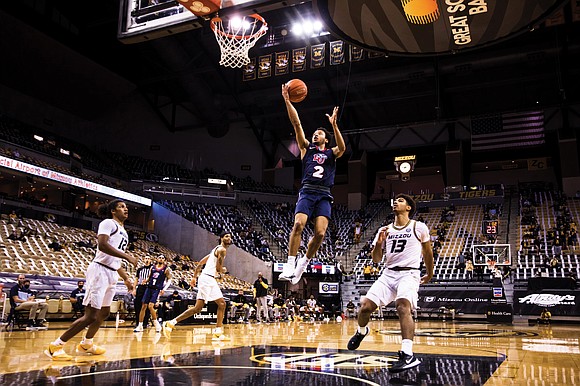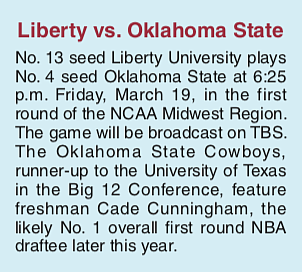NCAA: GOING TO THE BIG DANCE: Liberty University Flames player Darius McGhee rises to occasion
Fred Jeter | 3/18/2021, 6 p.m.
When the Liberty University Flames jump for joy, no one jumps higher than Darius McGhee.
Along with being the Atlantic Sun Conference Player of the Year, the 5-foot-9 junior is arguably the premier leaper in all of college hoops.
It’s fortunate the Roxboro, N.C., native isn’t scared of heights as the Flames make final preparations for their NCAA Tournament date with Oklahoma State at 6:25 p.m. Friday, March 19, in Indianapolis.
McGhee has recorded an oh-my-gosh 48-inch vertical leap. A video of the leap using a Vertec Vertical Jump Tester was shown last weekend on ESPN as Liberty won the Atlantic Sun Tournament and a NCAA bid under Coach Ritchie McKay.
“Our athletes are tested for vertical leap when they come onto campus,” said Liberty sports publicist Steven Gonzalez.
The vertical leap offers a strong indication of explosive athletic ability, and McGhee is brimming with it.
Some compare the vertical leap to football’s 40-yard dash in determining raw potential.
In Liberty’s 79-75 win over North Alabama in the nationally televised A-Sun final on March 7, McGhee had 21 points, made four 3-pointers and snared eight rebounds despite being the shortest man on the floor.
Earning A-Sun Player-of-the-Year honors for the 23-5 Flames, McGhee has averaged 16 points, five rebounds and two assists. He is hitting 46 percent from floor, 41 percent from behind the arc and 85 percent of his free throws.
Even more, he provides a “Wow!” factor few can match. It’s clear he can touch above the 18-inch rectangle above the rim and in the vicinity of the top of the backboard.
Basketball fans like to say a player “can jump out of gym.” While that may not be advisable, or even possible, if anyone can do it, it’s likely McGhee.
The vertical leap is determined by measuring an athlete’s standing height — tip toes to fingertips — and compar- ing it to his full extension, arm and hand extended leap.
Since the vertical leap is not an official track and field event, it’s hard making comparisons. There is no set protocol.
In Liberty’s case, McGhee’s jump was measured with about a 20-foot run-up before going airborne. This is often called “Max Leap” rather than “Standing Leap.”
Again, keeping in mind some of the testing might have been conducted dif- ferently, here are some recorded vertical leaps of note.
Kenny Gregory holds the NBACombine record of 45.5 inches, using run-up, in 2001. The 6-foot-6 wing from the University of Kansas was not drafted by the NBA but played about 10 years overseas.
The NFL holds its own version of the vertical leap.
Top efforts were 46 inches by Gerald Sensabaugh (from the University of North Carolina, 2005) and 45 inches by both Chris Conley (University of Georgia, 2015) and Donald Washington (Ohio State, 2009).
Cuban volleyball sensation Leonel Marshall, now 41, is reported to have had a 50-inch vertical leap with some YouTube evidence to support it.
Michael Wilson, a former player for the University of Memphis and the Harlem Globetrotters, is in the Guinness Book of World Records for dunking on the highest goal (12 feet) in history.
Any story about leapers would be incomplete without mention of Ray Ewry, “The Human Frog,” who won eight Olympic gold medals in the standing high jump, the standing long jump and the standing triple jump around the turn of the 20th century.
But that was then and McGhee is now.
After scoring more than 3,000 points in his high school career in Roxboro and at Blue Ridge School in Virginia, McGhee quickly made his way into Coach McKay’s lineup. He averaged 7.8 points as a freshman and 9.5 points last year. This year, he has taken off, which isn’t surprising.
Forget the calendar. Every year is a leap year for Darius McGhee.










